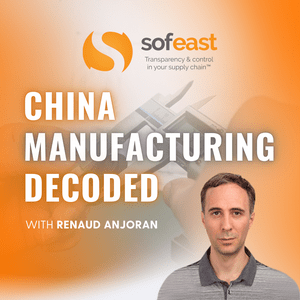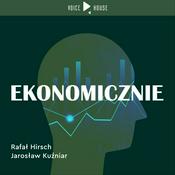Dostępne odcinki
5 z 131
- Spotting Kickbacks In China Manufacturing: Middlemen Could Be Costing YouHidden commissions and kickbacks can still be found in China sourcing, and many importers are unaware that they’re paying for them. In this episode, Adrian and Renaud unpack how these schemes work, how agents and trading companies quietly erode your margin, and what a more transparent, safer sourcing model looks like. Episode Sections: 00:00 – Intro & today’s topic: hidden commissions in China sourcing 01:32 – Agents vs trading companies: who are you really buying from? 03:01 – When a middleman does add value (and when they don’t) 07:48 – Transparent trading companies acting as a factory’s sales office 12:44 – Buyer-side agents, double commissions, and why it’s so tempting 18:01 – How traders quietly erode your margin with small opaque factories 21:48 – Short-term thinking, “circles” of trust, and why you’re outside of it 24:44 – Red flags with agents: pricing control, commission structure, and resistance to change 25:47 – Red flags with traders: factory visibility, visits, and compliance documents 26:56 – Moving to a safer model: when you may need a completely new supply chain 29:14 – Simple health-check: how well do you really know your supply chain? 31:00 – Why a lack of visibility puts your IP and business at risk 31:42 – Wrap-up, “health check your sourcing” call-to-action, and Sofeast support Related content... Agent vs. trader vs. importer: what differences? Is My Supplier A Trading Company Pretending To Be A Manufacturer? Do you need a sourcing agent to buy from China? Chinese Suppliers: “Are you my factory?” Hidden commissions between China factories and sourcing agents Get in touch with us Connect with us on LinkedIn Contact us via Sofeast's contact page Subscribe to our YouTube channel Prefer Facebook? Check us out on FB--------32:51
- Can You Afford to Manufacture Your Idea? Budget Truths from Idea to Mass ProductionAdrian is joined by Sofeast Group Head of New Product Development, Paul Adams, to unpack the brutal truth behind the question: “Can you actually afford to manufacture your new product idea?” They bust some of the most dangerous myths (like “MOQ × unit price is my total cost” and “we’ll fix reliability later”), then walk through Sofeast/Agilian’s 6-phase NPI process for electromechanical products and show how your budget is really consumed; from feasibility and prototyping through to tooling, pilot runs, and mass production. If you’re planning to launch a new product, this episode is your reality check and roadmap. Episode Sections: 00:00 – Intro & who this episode is for 07:02 – Mythbusting: YouTube & “$10k product launch” myths 12:13 – The Sofeast/Agilian 6-phase NPI process 21:18 – How your budget is split across the phases 29:00 – What to expect in each phase & readiness checks 37:31 – Tooling, NRE, and why half a tooling budget is worse than none 43:42 – Budgeting properly and adding contingency 45:21 – Call to action & how Sofeast/Agilian can help Related content... How to Calculate the Cash Needed to Prototype & Launch your New Product Why does new product development take so long? What is an NRE Cost (Non-Recurring Engineering)? 10 Factors Affecting Electronic Product Design Costs Costs and Milestones to go from Product Concept to Market? The New Product Development Process in Electronics New Product Development In China: 4 Tips To Go Faster Get in touch with us Connect with us on LinkedIn Contact us via Sofeast's contact page Subscribe to our YouTube channel Prefer Facebook? Check us out on FB--------47:05
- Mold in the Container: How to Protect Your Shipments from DevastationIn episode 304 of China Manufacturing Decoded, Adrian is joined by Kate (Sofeast’s Supply Chain Management Manager) to dig into one of the nastiest hidden risks importers face: mold. They explain how weeks inside a hot, humid shipping container can ruin textiles, leather, wood, packaging, and even electronics, if humidity and packaging aren’t under control. Don't sleep on this risk; it can affect anyone importing products from Asia! Episode Sections: 00:13 – Why importers don’t think about what happens inside the container 01:27 – How mold ruins products, packaging, and entire shipments (and which goods are most at risk) 03:02 – Why “mold explosions” happen: the 3 main causes (production humidity, packaging, container condensation) 06:27 – Factory controls: target humidity levels, drying products properly, and warehouse/storage pitfalls 08:56 – AC warehouses vs “regular” storage and what that really means for your goods 09:41 – Packaging controls: desiccants, export-grade cartons, minimizing empty air, plastic wrapping 10:31 – Logistics & container controls: dry containers, pallets, container desiccants, and rainy-season loading risks 13:16 – Case study: US home décor importer moves to India, spots high humidity, and ultimately cancels the order 18:11 – Desiccants 101: what they look like in cartons and containers, and why they’re “too cheap to ignore” 19:59 – Practical mold-prevention checklist for factories, packaging, and containers 23:56 – Is mold still a problem with air freight? Time, storage, and what to focus on if you ship by air 25:39 – Final advice: who’s most at risk and how Sofeast can help with packaging, inspections, and logistics controls Related content... Avoiding Mold on Imported Products Shipped in Ocean Containers Avoiding humidity inside containers 9 Types of Packaging (Benefits, Costs, Sustainability, and more) - Guide for Importers Get in touch with us Connect with us on LinkedIn Contact us via Sofeast's contact page Subscribe to our YouTube channel Prefer Facebook? Check us out on FB--------27:58
- How to Hire a Real Quality Manager in China/AsiaHiring a “quality manager” in China or Asia doesn’t always mean you’re getting someone who can actually protect your brand. In this episode, Renaud walks through how to tell a real quality leader from a simple document handler: the interview questions that expose true ISO 9001 competence, what strong (and weak) answers sound like, and how this role can either quietly drain money… or drive real improvement. Episode Sections: 00:00 – Cold Open: Can you trust that “quality manager”? 01:00 – Why the quality manager hire is a “hidden” benefit (or risk) 02:30 – Do you want a document pusher or an improvement leader? 04:45 – ISO 9001 “trick questions” that reveal real knowledge 07:00 – Can they explain the system, not just recite the standard? 09:20 – Scenario: lots of customer complaints – what do they actually do? 12:30 – Switching between “heavy” analysis and fast problem-solving 14:00 – What “profile” are you really looking for? 16:00 – Paying more for the right person vs. the cost of poor quality 18:00 – Wrap-up: Practical takeaways for your next hire Related content... Quality Manager Interview Questions To Test Knowledge Of ISO 9001 QA Strategy in China: 10 Elements You Should Include Basics about ISO 9001: The Standard and the Certification Process How a Chinese Factory Can Get ISO 9001 Certified What Factory CERTIFICATIONS Mean in China How a Factory Can (and Should) Go Beyond ISO 9001 Get in touch with us Connect with us on LinkedIn Contact us via Sofeast's contact page Subscribe to our YouTube channel Prefer Facebook? Check us out on FB--------19:05
- How to Reduce Injection Molding Costs Without Sacrificing Quality & ReliabilityAdrian and Paul break down why molding costs “balloon” (over-tight tolerances and cosmetic overkill) and then walk through three practical levers to cut costs safely: smarter tooling design & DFM (wall thickness, draft, gates, material choice), good tooling decisions (steel grades like P20 vs H13, cavity count, hot vs cold runners), and production/process tweaks (machine tonnage matching, sensible regrind use, SPC/sensors, in-tool de-gating). They finish with some tooling-costs myth-busting (cheap tools, mirror finishes, family molds). Episode Sections: 00:00 Intro & today’s topic 01:58 Why costs balloon: tolerances & cosmetics 06:52 Lever #1 — Design & DFM (wall thicknesses, material choice) 14:40 Lever #2 — Tooling decisions (steel grades, cavities) 22:44 Lever #3 — Processing & production setup 27:35 Myth-busting: cheap tools, mirror finishes, family molds 31:23 Recap & where the biggest savings really are Related content... Product Tooling: Possible To Avoid Paying for it in Full? Common Design For Manufacture Improvements On Plastic Injection Molded Parts When To Sign Off On Injection Mold Tooling? Inside the Journey from DFM to T0→T2 [Podcast] Plastic Playbook: Choosing The Right Polymer [Podcast] Mold Tooling Ownership: The term Chinese suppliers push for will shock you! The Conundrum of Investing in Tooling Before a Final Prototype Get in touch with us Connect with us on LinkedIn Contact us via Sofeast's contact page Subscribe to our YouTube channel Prefer Facebook? Check us out on FB--------34:02
Więcej Biznes podcastów
Trendy w podcaście Biznes
O China Manufacturing Decoded
Join Renaud Anjoran, Founder & CEO of Sofeast, in this podcast aimed at importers who develop their own products as he discusses the hottest topics and shares actionable tips for manufacturing in China & Asia today!WHO IS RENAUD?Renaud is a French ISO 9001 & 14001 certified lead auditor, ASQ certified Quality Engineer and Quality Manager who has been working in the Chinese manufacturing industry since 2005. He is the founder of the Sofeast group that has over 200 staff globally and offers services (QA, product development & engineering, project management, Supply Chain Management, product compliance, reliability testing), contract manufacturing, and 3PL fulfillment for importers and businesses who develop their own products and buyers from China & SE Asia.WHY LISTEN?We‘ll discuss interesting topics for anyone who develops and sources their products from Asian suppliers and will share Renaud‘s decades of manufacturing experience, as well as inviting guests from the industry to get a different viewpoint. Our goal is to help you get better results and end up with suppliers and products that exceed your expectations!
Strona internetowa podcastuSłuchaj China Manufacturing Decoded, Inwestomat - oszczędzanie, inwestowanie, wolność finansowa i wielu innych podcastów z całego świata dzięki aplikacji radio.pl

Uzyskaj bezpłatną aplikację radio.pl
- Stacje i podcasty do zakładek
- Strumieniuj przez Wi-Fi lub Bluetooth
- Obsługuje Carplay & Android Auto
- Jeszcze więcej funkcjonalności
Uzyskaj bezpłatną aplikację radio.pl
- Stacje i podcasty do zakładek
- Strumieniuj przez Wi-Fi lub Bluetooth
- Obsługuje Carplay & Android Auto
- Jeszcze więcej funkcjonalności


China Manufacturing Decoded
Zeskanuj kod,
pobierz aplikację,
zacznij słuchać.
pobierz aplikację,
zacznij słuchać.






































